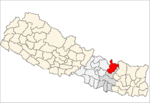Dolakha District
Dolakha, often known as Dolkha or Dholkha (Nepali: दोलखा जिल्ला![]()
Dolakha District दोलखा | |
|---|---|
District | |
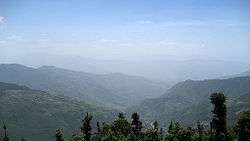 Dolakha District | |
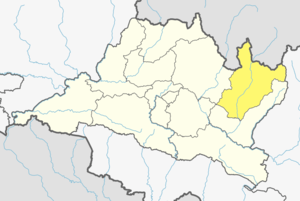 Location of district in Bagmati Pradesh | |
| Country | |
| Province | Bagmati Pradesh |
| Admin HQ. | Charikot (Bhimeshwar |
| Government | |
| • Type | Coordination committee |
| • Body | DCC, Dolakha |
| Area | |
| • Total | 2,191 km2 (846 sq mi) |
| Population (2011) | |
| • Total | 186,557 |
| • Density | 85/km2 (220/sq mi) |
| Time zone | UTC+05:45 (NPT) |
| Main Language(s) | Nepali |
| Website | www |
The name Dolkha arose from the Sherpa community. In the Sherpa´s language "DO" means stone (dhunga), "LA" means in (maa), and "KHA" means face (mukh) which means "Face in Stone" (dunga ma mukh).
Bhimeshwar Temple
The Bhimeshwar temple is located in Dolakha Bazar of Bhimeshwar. The main statue of this temple is God Bhim. Bhimsen, Bhimeshwar, or Bhim of Dolakha is noted as one of the most popular throughout the country. He was the second prince of Panch Pandav and notably worshiped by the traders or merchandisers as their god. In Dolakha, the roofless temple constitutes the idol of Bhimsen, which is triangular in shape and made of rough stone. The idol in the temple is said to resemble three different gods: Bhimeshwar in the morning, Mahadeva during the day and the Narayana in the evening.
Local legend has it that ages ago, 12 porters coming from elsewhere stopped at this spot and made three stone stoves to cook rice. After a few minutes, it was noticed that one side of the rice grains was cooked but the other side was raw. When the Porter flipped the cooked side up, the cooked rice became raw again when it came in contact with the triangular-shaped black-stone. One of the porters became very angry and stabbed the stone with "Paneu" (laddle), which cut the stone and out of the cut flowed blood coated with milk. Later they realized that the stone is God Bhim. Worshippers started pouring in to pray to God Bhim. There are many faith-challenging incidents about the Bhimsen of Dolakha. The miraculous things of Bhimsen statue of Dolakha include sweating fluid like drops of warm water. People believe that if any bad incident is happening or going to happen in near future in the country then Bhimsen himself tries to protect his people by warning them through sweating etc.
From the point of view of Shree Bhimeshwar Shivapuran, there was a kingdom of Bhima that was blessed by God Brahma at the side of a mountain peak. The people, who lived in the Bhima's kingdom had to live very sorrowful lives from the Bhima and so they prayed to god Shiva to save their lives. Then God Shiva came from Gaurishanker and killed the king Bhima. According to the history after Bhima's death, the statue of God at that spot was named -Bhimeshwar (भिमेश्वर).
Dolakha is also home to another holy temple - Kalinchowk Bhagawati. It is situated in high mountains at an altitude of about 3842m and the pilgrims are known to walk a long and dangerous route via the mountains to the temple. But, in 2018 the government started a new cable car service for the comfort of the pilgrims. The temple is believed to have strong spiritual power and known to fulfill the prayer of the pilgrims. [2]
Geography and climate
| Climate Zone[3] | Elevation Range | % of Area |
|---|---|---|
| Upper Tropical | 300 to 1,000 meters 1,000 to 3,300 ft. |
1.9% |
| Subtropical | 1,000 to 2,000 meters 3,300 to 6,600 ft. |
26.2% |
| Temperate | 2,000 to 3,000 meters 6,400 to 9,800 ft. |
28.5% |
| Subalpine | 3,000 to 4,000 meters 9,800 to 13,100 ft. |
16.6% |
| Alpine | 4,000 to 5,000 meters 13,100 to 16,400 ft. |
9.4% |
| Nival | above 5,000 meters | 17.4% |
Demographics
At the time of the 2011 Nepal census, Dolakha District had a population of 186,557. Of these, 65.2% spoke Nepali, 15.8% Tamang, 8.0% Thami, 7.6% Sherpa, 2.3% Jirel, 2.0% Newari and 1.0% Sunuwar as their first language.
32.5% of the population in the district spoke Nepali and 0.6% English as their second language.[4]
Administration
The district consists of 9 Municipalities, out of which two are urban municipalities and seven are rural municipalities. These are as follows:[5]
- Bhimeswor Municipality
- Jiri Municipality
- Kalinchok Rural Municipality
- Melung Rural Municipality
- Bigu Rural Municipality
- Gaurishankar Rural Municipality
- Baiteshwor Rural Municipality
- Sailung Rural Municipality
- Tamakoshi Rural Municipality
Former Municipalities and Village Development Committees (VDCs)

Prior to the restructuring of the district, Dolakha consisted of the following municipalities and Village development committees:
- Alampu
- Babare
- Bhedapu
- Bhimeshwar Municipality
- Bhirkot
- Bhusapheda
- Bigu
- Bocha
- Bulung
- Chankhu
- Chhetrapa
- Chilankha
- Chyama
- Dadhpokhari
- Dandakharka
- Dolakha Town
- Gairimudi
- Gauri Sankar
- Ghang Sukathokar
- Hawa
- Japhe
- Jhule
- Jhyaku
- Jiri Municipality
- Jugu
- Kabhre
- Kalinchok
- Katakuti
- Khare
- Khupachagu
- Laduk
- Lakuri Danda
- Lamabagar
- Lamidanda
- Lapilang
- Magapauwa
- Makaibari
- Mali, now Jiri Mun.
- Malu
- Marbu
- Mati
- Melung
- Mirge
- Namdu
- Orang
- Pawati
- Phasku
- Sahare
- Shailungeshwar
- Sunakhani
- Sundrawati
- Suri
- Susma Chhemawati
- Syama
- Thulopatal, now Jiri Mun.
Gallery
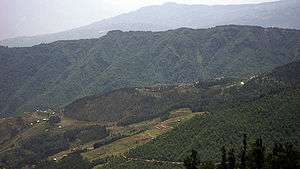 Near Charikot
Near Charikot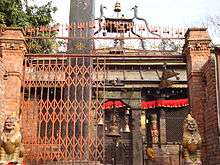 Dolakha Bhimsen Temple
Dolakha Bhimsen Temple Kalinchowk
Kalinchowk Jiri
Jiri- Khari dhunga Dolakha Nepal
- Himalayan range GAURISHANKAR
- View
See also
- Zones of Nepal
- Dolakha Newar Language
- Thangmi language
- Informative page about Dolakha
References
- "National Population and Housing Census 2011(National Report)" (PDF). Central Bureau of Statistics. Government of Nepal. November 2012. Archived from the original (PDF) on 2013-04-18. Retrieved November 2012. Check date values in:
|accessdate=(help) - https://www.google.com.au/imgres?imgurl=https%3A%2F%2Fupload.wikimedia.org%2Fwikipedia%2Fcommons%2Fd%2Fde%2FKalinchok_bhagawati_Statue.JPG&imgrefurl=https%3A%2F%2Fen.wikipedia.org%2Fwiki%2FKalinchowk_Bhagwati_Shrine&docid=h5nWQvxjwF1s5M&tbnid=_otcu9BQvzDMUM%3A&vet=10ahUKEwi2x6St94_hAhVLeH0KHcq5DvkQMwhAKAIwAg..i&w=1620&h=1080&bih=969&biw=1920&q=altitude%20of%20kalinchowk%20temple&ved=0ahUKEwi2x6St94_hAhVLeH0KHcq5DvkQMwhAKAIwAg&iact=mrc&uact=8
- The Map of Potential Vegetation of Nepal - a forestry/agroecological/biodiversity classification system (PDF), . Forest & Landscape Development and Environment Series 2-2005 and CFC-TIS Document Series No.110., 2005, ISBN 87-7903-210-9, retrieved Nov 22, 2013
- 2011 Nepal Census, Social Characteristics Tables
- "स्थानिय तह" (in Nepali). Ministry of Federal Affairs and General Administration. Retrieved 1 September 2018.
- "Districts of Nepal". Statoids.
| Wikimedia Commons has media related to Dolakha District. |
